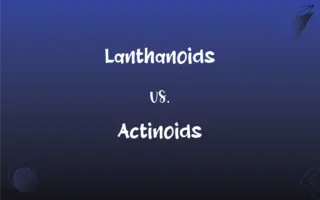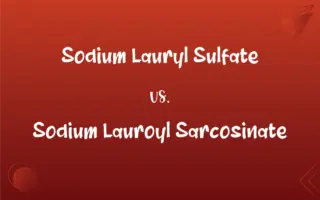Lactide vs. Lactone: What's the Difference?
Edited by Janet White || By Harlon Moss || Published on January 15, 2024
Lactide is a cyclic di-ester formed from lactic acid. Lactone is a cyclic ester formed from hydroxycarboxylic acids.

Key Differences
Lactide is a cyclic di-ester specifically derived from the polymerization of lactic acid. In contrast, lactone refers to a broader category of cyclic esters formed from various hydroxycarboxylic acids.
Lactide is typically associated with biodegradable polymers like polylactic acid (PLA), crucial in biomedical applications. Lactone, on the other hand, includes a wide range of compounds, many of which occur naturally in fruits and are used in flavors and fragrances.
The formation of lactide involves the dehydration of two lactic acid molecules, resulting in a ring structure. Lactone formation, however, can occur from a single hydroxycarboxylic acid molecule undergoing intramolecular esterification.
In terms of chemical structure, lactide possesses a more rigid, symmetrical ring, while lactones vary widely in ring size and substitution, influencing their chemical properties.
Lactide is significant in industrial contexts, particularly in the production of biodegradable plastics. Lactones have diverse applications, ranging from pharmaceuticals to flavoring agents, due to their varied structures and properties.
ADVERTISEMENT
Comparison Chart
Origin
Derived from lactic acid
Derived from various hydroxycarboxylic acids
Chemical Structure
Cyclic di-ester
Cyclic ester
Ring Formation
From two lactic acid molecules
From a single hydroxycarboxylic acid molecule
Applications
Biodegradable plastics, biomedical
Flavors, fragrances, pharmaceuticals
Ring Characteristics
Rigid, symmetrical
Varies in size and substitution
ADVERTISEMENT
Lactide and Lactone Definitions
Lactide
A cyclic ester of lactic acid.
The production of polylactic acid involves the polymerization of lactide.
Lactone
A naturally occurring compound in many fruits.
The pleasant aroma of peaches is partly due to the presence of lactone.
Lactide
A molecule used in biomedical applications, especially in sutures.
Lactide-based sutures dissolve naturally in the body after surgery.
Lactone
A cyclic ester formed from hydroxycarboxylic acids.
γ-Butyrolactone, a common lactone, is used as an industrial solvent.
Lactide
A compound formed by the dehydration of lactic acid.
Lactide's formation is a critical step in creating certain biopolymers.
Lactone
A component in many flavoring and fragrance agents.
Lactone compounds contribute to the creamy note in certain perfumes.
Lactide
A key intermediate in biodegradable plastic manufacturing.
Lactide is essential for producing eco-friendly packaging materials.
Lactone
A versatile chemical used in pharmaceutical synthesis.
Certain lactones are key intermediates in the production of antibiotics.
Lactide
A building block for polylactic acid (PLA), a bioplastic.
Lactide is polymerized to form PLA, used in 3D printing.
Lactone
A ring-shaped molecule found in various organic compounds.
The lactone ring is crucial in the structure of many natural products.
Lactide
(organic chemistry) Any of a class of heterocyclic compounds, formally acid anhydrides, formed by heating α-lactones
Lactone
A cyclic ester, or a compound containing a cyclic ester, formed by the intramolecular condensation of a hydroxy carboxylic acid.
Lactide
(organic compound) The anhydride of lactic acid
Lactone
(organic chemistry) A cyclic intramolecular ester derived from a hydroxy acid
Lactide
A white, crystalline substance, obtained from lactic acid by distillation, and regarded as an anhydride; also, by extension, any similar substance.
Lactone
One of a series of organic compounds, being cyclic esters which may be regarded as anhydrides of certain hydroxy acids. In general, they are colorless liquids, having a weak aromatic odor. They are so called because the typical lactone is derived from lactic acid.
FAQs
What is lactide?
Lactide is a cyclic di-ester derived from lactic acid, used in bioplastics.
How is lactide formed?
Lactide forms through the dehydration of two lactic acid molecules.
Are lactones safe in cosmetics?
Yes, many lactones are used safely in cosmetics, particularly for fragrance.
Are lactide and lactone environmentally friendly?
Lactide is known for its role in biodegradable plastics; lactones vary in environmental impact based on their specific type and use.
Where are lactones found?
Lactones occur naturally in fruits and are used in many synthetic applications.
Can lactide be used in medical applications?
Yes, lactide is used in biomedical applications like biodegradable sutures.
What is the main use of lactone in the food industry?
Lactones are used as flavoring agents, imparting characteristic aromas to food products.
Is lactide recyclable?
Lactide-based polymers like PLA are biodegradable and industrially compostable.
What is lactone?
Lactone is a cyclic ester found in various organic compounds, including flavors and fragrances.
Is lactide naturally occurring?
Lactide is synthetically derived from natural lactic acid.
What makes lactide important in sustainability?
Lactide's role in producing biodegradable plastics makes it key to sustainable materials.
How does lactide contribute to 3D printing?
Lactide is used to produce PLA, a common material in 3D printing.
Can lactone be used in pharmaceuticals?
Yes, lactones are versatile in pharmaceutical synthesis, including antibiotics.
How does the chemical structure of lactide affect its properties?
The symmetrical ring structure of lactide imparts stability and rigidity, important for polymer applications.
Do lactones have a role in perfumery?
Yes, lactones contribute creamy, fruity notes to perfumes.
Are lactones present in all fruits?
Many, but not all, fruits contain lactones contributing to their aroma.
Are lactide and lactone used in the same industries?
They overlap in some areas, like biodegradable materials, but lactone's usage is broader in flavors and pharmaceuticals.
Can lactones be synthetic?
Yes, lactones can be both naturally occurring and synthetically produced.
What is the environmental impact of lactone usage?
The impact varies; natural lactones are generally eco-friendly, while synthetic ones depend on their application and disposal.
What distinguishes lactide from other bioplastics?
Lactide is unique due to its origin from lactic acid and biodegradability.
About Author
Written by
Harlon MossHarlon is a seasoned quality moderator and accomplished content writer for Difference Wiki. An alumnus of the prestigious University of California, he earned his degree in Computer Science. Leveraging his academic background, Harlon brings a meticulous and informed perspective to his work, ensuring content accuracy and excellence.
Edited by
Janet WhiteJanet White has been an esteemed writer and blogger for Difference Wiki. Holding a Master's degree in Science and Medical Journalism from the prestigious Boston University, she has consistently demonstrated her expertise and passion for her field. When she's not immersed in her work, Janet relishes her time exercising, delving into a good book, and cherishing moments with friends and family.


































































